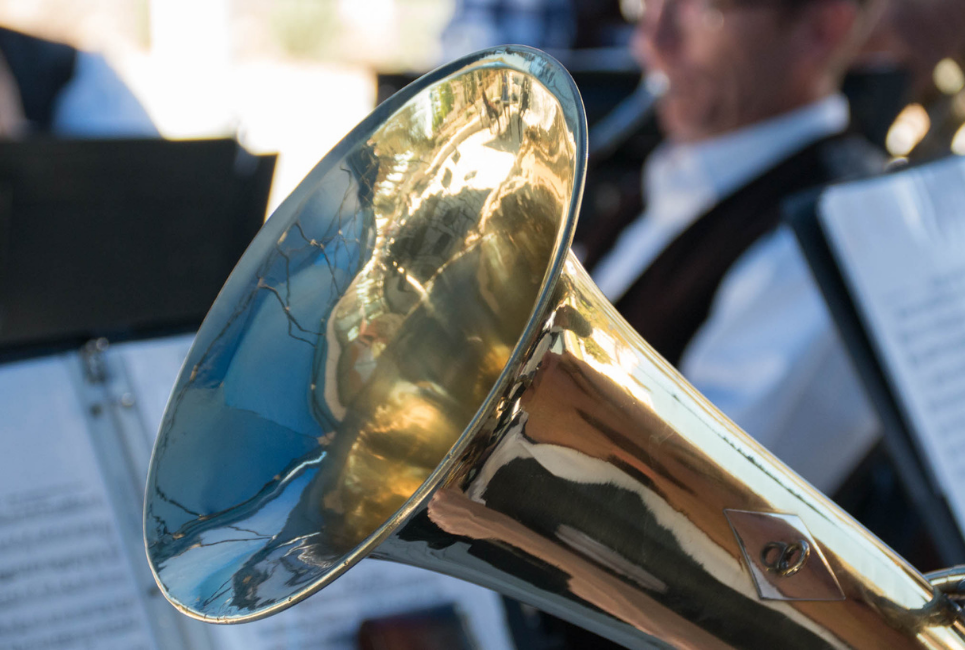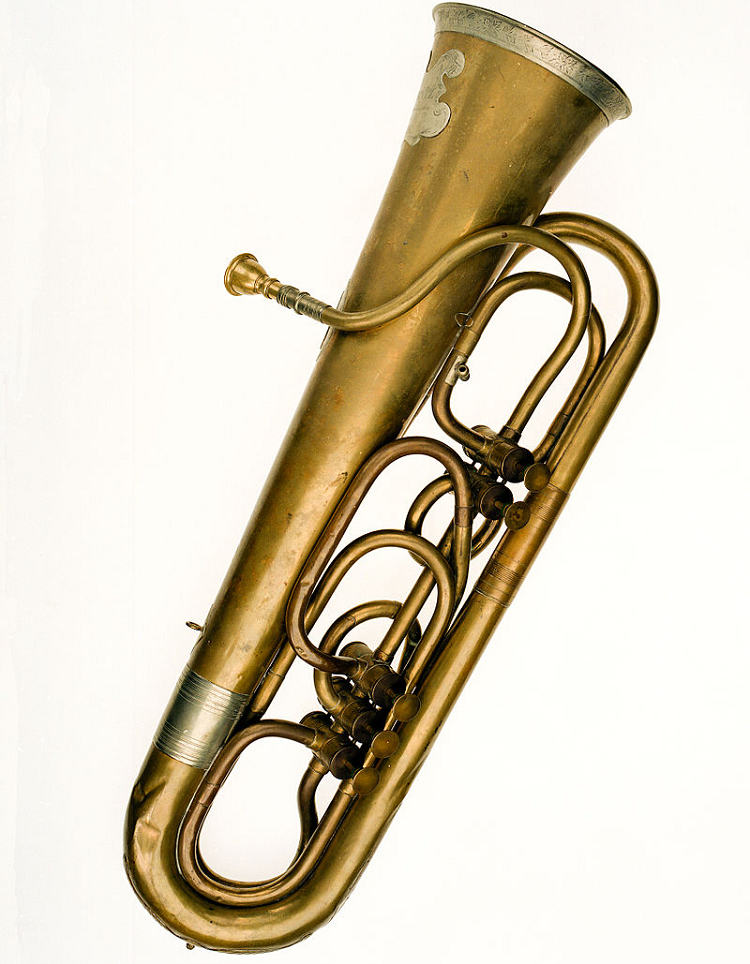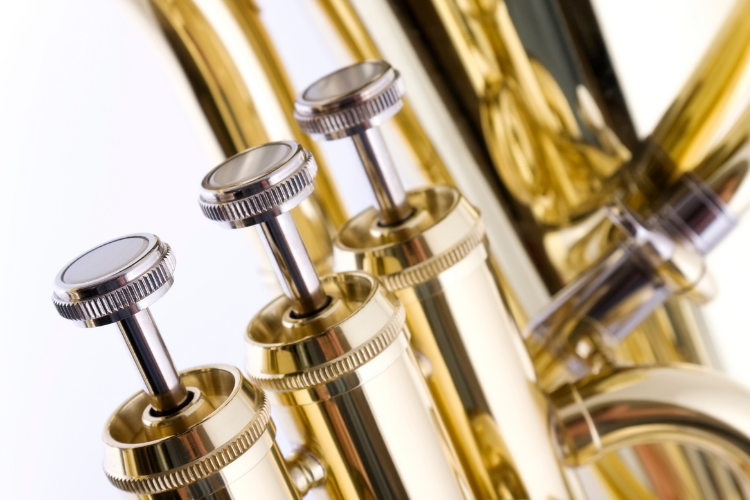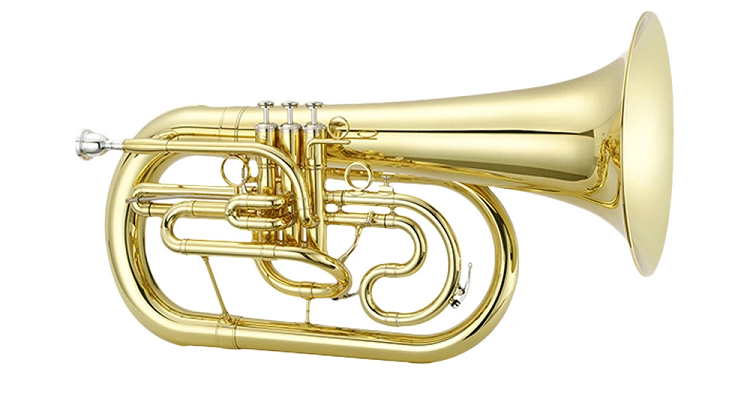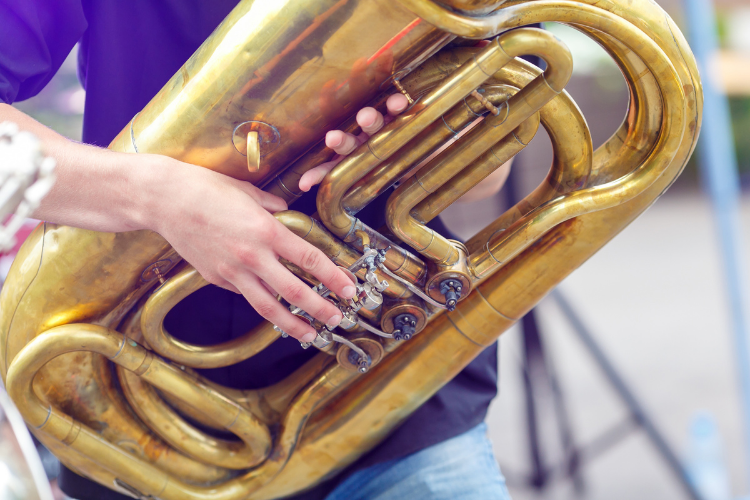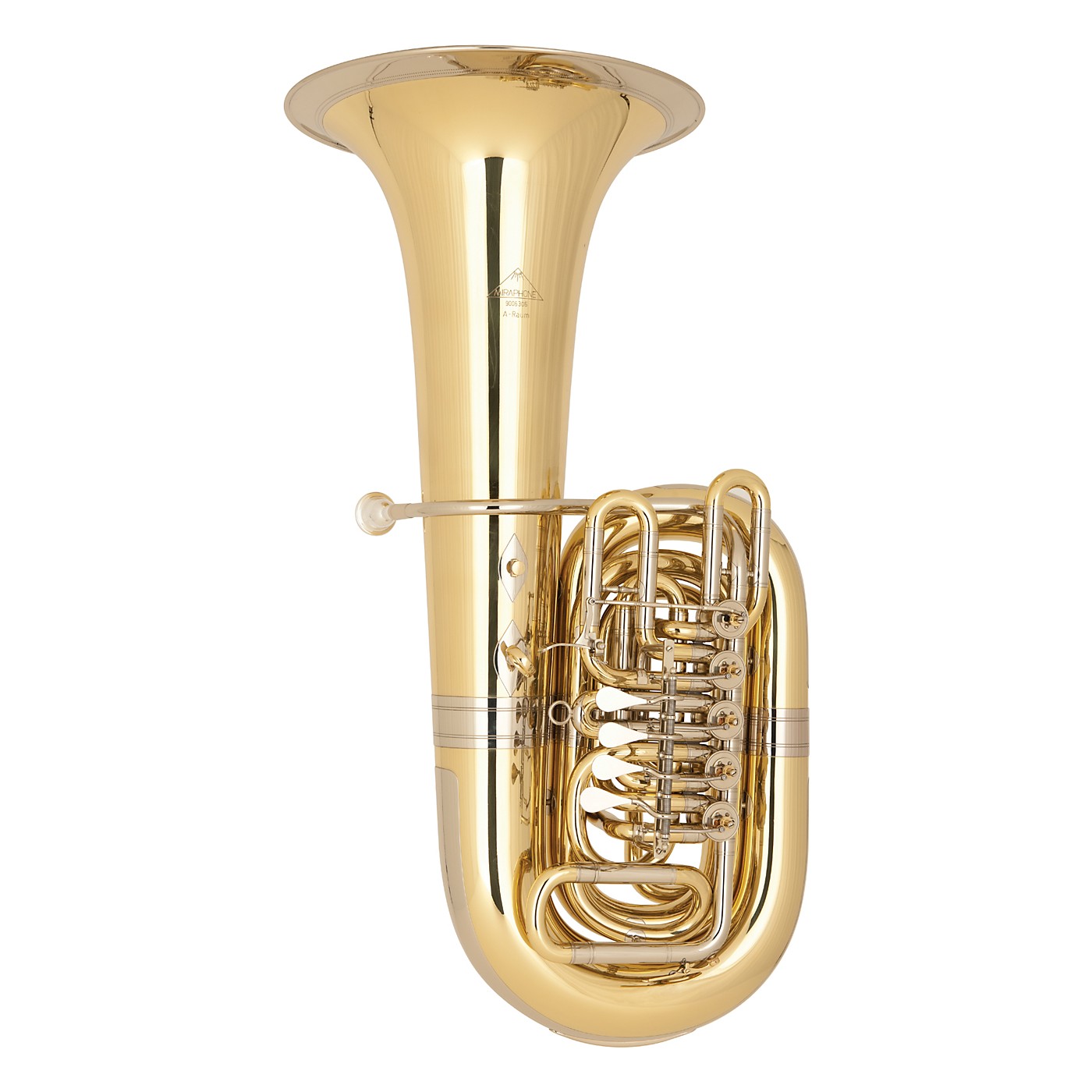- How to Find the Best Alto Trombone - May 31, 2022
- How to Find the Best Bass Trumpets - April 23, 2022
- Best Yamaha Saxophones Brand Guide - April 21, 2022
At first glance it’s easy to think of the euphonium as a tuba that got shrunk in the wash. Some people even call the euphonium a “tenor tuba.” But the euphonium is a fascinating and versatile instrument that deserves to be better known.
While euphoniums are an important part of British brass bands, and seen in many brass ensembles elsewhere, they are not nearly so popular or well-known as their bigger cousins.
So what’s the difference between a euphonium and a tuba?
Main Differences Between Euphonium vs Tuba
- Euphoniums come in a standardized size and key, whereas tubas are built in several different size and keys.
- Euphoniums play in the baritone range, whereas tubas play in the bass range.
- Euphoniums are made with around nine feet of conical tubing, whereas tubas are made with around 18 feet.
- Euphoniums are found in a few specialized musical settings, whereas tubas have a more widespread appeal.
Euphoniums and tubas have more similarities than differences, which is not surprising given their history. To find out more, let’s go back to the 19th century and the dawn of valved brass instruments.
The History of Euphoniums and Tubas
On September 11, 1835 a German instrument maker named Johann Moritz filed a patent for his basstuba. The basstuba could play down to F1, an octave below the serpents and ophicleides that were then in use.
To reach these depths, 12 feet of tubing were connected through five Berliner Pumpenvalven, forerunners of today’s piston valves. Soon after filing his patent Johann retired. His son Carl Wilhelm (C.W.) Moritz took over the family business and between 1835 and 1845 produced 84 of these instruments.
In 1838 Carl Wilhelm also began producing half-sized “tenor tubas” that played an octave above the larger basstuba.
In 1843 Ferdinand Sommer of Weimar introduced a similarly-sized valved instrument he called a “euphonion.” That same year in France Adolph Sax created a tenor brass saxhorn. Historians differ on which was the forerunner of the modern euphonium. All three likely played some role in the final design.
These valved instruments changed tubing length by connecting and disconnecting lengths of pipe. But the ratios which create chromatic scales are complex, and many valve combinations were off pitch. Small differences could be fixed by embouchure but some combinations were so dissonant as to be useless.
Then, in 1874, the British music firm Boosey & Co. introduced euphoniums with compensating valves that could correct those off-key combinations. These compensating valves would later be introduced on tubas as well.
Euphoniums are most frequently seen in brass ensembles and marching bands. The euphonium covers much the same range as the tenor trombone.
Though the euphonium does not enjoy the same cross-genre acceptance as the tuba, it is loved by those who play it and those who enjoy brass music. And if you don’t love the euphonium, you just haven’t heard one yet.
Here’s euphonium player Anthony Caillet playing “Café 1930” by Argentine tango composer Oscar Piazzolla:
Euphonium vs Tuba: Breaking Down the Differences
Tubing
The euphonium is made in the key of B♭ and pitched an octave above a BB♭ tuba. That means a euphonium requires half the tubing length of a tuba.
Going down an octave on a brass or wind instrument requires twice the body length. To produce C1 on an organ requires a 16-foot long pipe, only a few very large organs have the 32-foot long pipes that produce a C0.
An unwrapped BB♭ tuba would be slightly longer than a C1 pipe. A BB♭ tuba’s lowest natural note with all valves open is B♭0, a full step below C1. The natural note for a euphonium with all valves open is B♭1, an octave higher and a full step below C2.
But tubas are made in several other keys. C tubas naturally pitched to C1 are popular in many orchestras, while tuba soloists use E♭ or F trumpets for pieces that call on the tuba’s highest range.
(If that isn’t confusing enough, many 19th century French works by composers like Ravel and Saint-Saëns were written for “French tubas” whose natural note was C2, a full step higher than a euphonium!)
Skilled tuba and euphonium players can use their embouchure and breathing to produce pedal notes below the fundamental (open) series. “Encounters II,” a piece written for tuba legend Roger Bobo, calls for a C0. That’s a full octave below the piano’s lowest C and requires leather lungs and perfect lip control.
With pedal notes a euphonium player can get down into the tuba’s lower register, though the notes will lack some of the overtones and power you get from the bigger tuba.
Both tubas and euphoniums are built with conical tubing that grows wider as you move away from the mouthpiece and leadpipe.
With woodwinds a conical bore generally makes the sound more penetrating and edgy. Nobody will mistake the sound of a cylindrical clarinet for the conical soprano saxophone! But with brass instruments a conical bore produces a warmer and softer sound.
The euphonium gets its name from the Greek euphōnos or “sweet-voiced.” Its warm round velvety tone persists throughout its range, making the euphonium one of the brass band’s most versatile players.
While tubas are often dismissed as funny-sounding oompah machines, a skilled tubist can make the big instrument sound as mellow and sweet as a French horn.
Valves
Every euphonium has three top action valves. Professional euphoniums have a fourth compensating valve, generally on the left side and triggered with the index finger.
Student euphoniums only have three valves, while many intermediate euphoniums have a fourth valve which offers alternate fingerings but does not compensate for the off-key combinations nor bring them closer to the scale.
These instruments will be suited for most euphonium music, and will be lighter for marching, but will require more lipping and tuning slide effort on the player’s part.
Amateur tubas also have three valves, but most serious tubists use four- or five-valve instruments. While compensating valve systems exist for tuba, most tubists prefer non-compensating tubas.
The added valves and tubing that bring the notes back in tune also make the tuba feel stuffier and harder to play. Extra resistance you might barely notice on a euphonium can become a real problem when you’re trying to fill a big tuba with air.
With rare exceptions, euphoniums are built with piston valves. While you often see piston valves on tubas, rotary valve tubas are popular in Eastern Europe and frequently used for 19th century German symphonic music.
You will also find water keys, more commonly called spit valves, on both euphoniums and tubas. Spit valves let musicians drain moisture from their instrument tubing. This helps prevent corrosion.
Bell
The bell helps amplify and project a brass instrument’s sound, but it also raises the lower resonances and helps tune the harmonic sequences. The bell also allows brass instruments to produce pedal tones an octave below the series fundamentals.
Euphonium bells are generally between 11 and 12 inches. Tuba bells range typically range between 17 and 22 inches.
Larger bells give you a mellower, more resonant sound but they also make the instrument’s response slower. A smaller bell gives you clear and distinct fast passages but can produce a harsher, more aggressive tone.
The valve placement on your tuba will determine whether you play with your bell against your left or right shoulder. Top action valve tubas are played with the bell on the right.
Front action and rotary valve tubas are played with the bell on the left shoulder. The overwhelming majority of euphoniums are top action and played with the bell toward the right.
Leadpipe
Between your mouthpiece and brass instrument there is a leadpipe that connects them. This unspectacular piece of tubing has a great influence on the sound of your tuba or euphonium and an even bigger impact on the way the instrument plays.
The resistance provided by the leadpipe results in back pressure that you can feel as you play. This feedback helps you adjust embouchure and breathing as necessary.
Too little resistance and you will have difficulty slotting notes and correcting intonation. Too much resistance and your instrument will feel stuffy and hard to blow.
A concert tuba’s leadpipe is placed so that the tubist can hold the instrument on their lap while playing. A marching tuba’s leadpipe lets the tubist play with the tuba on their shoulder. (You can learn more in my article on the best marching tubas).
Marching euphoniums have their leadpipe repositioned so that the euphonium can be held like a large trumpet. The marching euphonium’s range and size are actually comparable to a bass trumpet.
Mouthpiece
Other than size, brass mouthpieces look very similar. Players press their lips against a circular rim and buzz into a rounded or conical metal cup.
This vibration moves down the mouthpiece throat and leadpipe, then resonates through the instrument and becomes music. Because a tuba needs a stronger resonance than the euphonium, tuba mouthpieces are larger than euphonium mouthpieces.
Many trombone mouthpieces will fit a euphonium and work very well, especially in the higher registers. As you grow more advanced in your euphonium skill, you may want to look for a dedicated euphonium mouthpiece.
These mouthpieces are a bit more conical than trombone mouthpieces and will better fit your euphonium’s leadpipe, giving you better tone and feedback.
Euphonium Music vs. Tuba Music
Most music written for euphonium and tuba is written at concert pitch using a bass clef. Tubas and euphoniums are generally treated as non-transposing instruments. Transposing B♭ instruments like the clarinet and trumpet play notes a full step below what is written. Euphonium players and tubists play the notes as they are written.
The big exception to this rule is British brass band music. English composers for brass band traditionally scored for euphoniums and tubas as transposing instruments.
Music for euphoniums and B♭ tubas was written in treble clef. The euphonium played a full ninth (an octave + a step) lower, while the tuba played the line two octaves lower.
Brass band music is just one small part of the available tuba repertoire. Euphoniums achieved their greatest popularity in England and a significant chunk of the available euphonium repertoire was written for British brass bands and light music ensembles using the transposing treble clef conventions.
A euphonium player should also become comfortable reading treble clef and sight-transposing music in different keys. While an advanced tubist will need to master these skills as well, they will be less immediately necessary.
The good news for euphonium players: once you master those skills, you will be able to play a great deal of trumpet repertoire in a velvety baritone.
While the euphonium is often treated as a small tuba, you can just as easily treat it as a big trumpet. And since the euphonium shares much of its range with the trombone, you can adapt a lot of trombone music for your euphonium as well.
Products Recommendations
Now that you know the difference, you probably wonder which Euphonium or Tuba would be the best to buy. Well, that’s a tricky question. These are expensive instruments, and if you are paying over 1000 dollars for something, you want it to be top quality.
When it comes to brass and woodwind instruments, I find the brand and then model to be the most significant quality indicator. Of course, nothing will compare to play testing your new instrument. This is especially true if you are buying used. If you like any of these Tuba or Euphoniums, head over to your local music store and see if you can try it out.
These products were chosen primarily based on their brand reputation. Looking for instruments from well-known makers like Yamaha and Jupiter means getting higher quality instruments. For something so expensive, it’s worth paying the price for a better brand.
Tuba
Student Pick- Yamaha YBB-321WC
Tubas are expensive; there is no way around it, and even a student pick can run you several thousand dollars, so why not get one that you know will last. Yamaha is known for making quality instruments, among other products. You can find everything from strings to brass instruments and their accessories in the music world.
Yamaha has you covered whether you need an instrument for your band room or personal use. The YBB-321WC has 4 top action piston valves made from yellow brass for a brighter tone. It’s tuned to the key of B flat and has an upright bell position perfect for most band or orchestra settings.
It’s an expensive tuba, but it will last a student or a band room a very long time provided it’s well cared for. You can get the tuba in either a lacquer finish or silver finish. The lacquer finish is your best bet for students or a band room. Silver is beautiful, but it requires a lot of upkeep to keep it from tarnishing. Younger students may not handle the responsibility, and older students may not want to deal with it. Lacquer doesn’t require constant polishing and won’t tarnish.
CC Tuba- Miraphone 186
Miraphone is a German company and is one of the top brands for brass instruments, and I can see why. They’ve been around for over 75 years but have roots dating even farther back. Their focus is to create top-quality instruments backed by knowledge and skills formed and passed on before World War 2 when brass instruments were still primarily manufactured in Czechoslovakia.
The Miraphone 186 is a CC tuba with rotary valves and is perfect for an advancing tuba player. I wouldn’t recommend this tuba to a brand new beginner;. In contrast, CC tubas are smaller and more popular in orchestra settings; the rotary valves can be frustrating for new players. However, this is an excellent choice for expanding their horizons.
This particular model is a 4 valve tuba made with yellow brass. Players will enjoy how responsive this tuba is and the overall well-rounded tone. Ultimately this is perfect for someone who has their sites set on playing orchestras. Those who primarily use their instrument for marching will want a BBb tuba.
Professional Pick- Miraphone 1291
If you are a professional, you’ll want the best you can get and what you feel most comfortable playing. With this in mind, I would try to test out any tuba that strikes your fancy before purchasing. But, I have confidence that most professionals will like the Miraphone 1291, especially if you are after a piston valve instead of a rotary valve.
As I’ve mentioned, Miraphone is one of the top brass instrument brands, so you know you will get top quality. This model is available in BBb and CC for orchestral or band performances and marching bands. Unlike the other options on this list, the Miraphone 1291 is a 5 valve tuba allowing for an open lower range and better intonation. This is great for players who want more control over their tone, especially professionals, where it can be essential.
The tuba is made from yellow brass to have an overall more brilliant tone. On deeper instruments, this is something I do enjoy as it brings a touch of pizzaz to their repertoire. Overall the type of brass used is entirely up to preference. I’d choose gold or red brass if I was buying a professional instrument personally.
Euphonium
Compensating Euphonium- Yamaha YEP-642II
Like tubas, euphoniums are expensive as well. They also come in a variety of forms. The Yamaha YEP 642T Neo is a compensating Euphonium created to collaborate between Yamaha and Bill Millar, a world-renowned brass band conductor.
This euphonium has a 3 top and 1 side-valve configuration and a main tuning slide trigger system for precise pitch control and solid tone. This means that you can drop the tuning slider trigger to lower the pitch a set amount while playing or adjust it before a performance for a perfect tune.
Since this instrument comes from Yamaha and is well known for collaborations with artists who are experts in their instruments, you know you will get a top-quality Tuba for your money. Furthermore, a compensating Tuba will help you have better intonation. At the same time, this is more expensive, but it can help players in the learning process.
Non-Compensating Euphonium- Yamaha YEP-321
This euphonium is one of the most popular instruments for advancing players and band directors who need something for their band. It’s made from yellow brass and has 4 top action valves that are very smooth. Despite being non-compensating, this tuba is terrific for helping students learn and feel for correct intonation.
This euphonium features gold brass leadpipe with yellow brass valve casing and a smaller bore. This means that younger players or new players won’t need as much air control, but the tone will be brighter. Along with the usual lacquer or silver finish choices. Unless you are ready for the upkeep of silver, the lacquer is the way to go.
Professional Euphonium- Miraphone M505
If you really want a top-quality euphonium, then Miraphone is always a great brand to check out. The M505 is one of their highest quality Euphoniums. Unlike other instruments on his list, you can’t get it with a lacquer finish, but the silver is gorgeous. This instrument is fantastic for professionals who don’t mind a bit of extra polishing.
This euphonium is a collaboration between Miraphone and Demondre Thurman. It has 4 compensation valves in 3 top and 1 side configuration. It has a larger bore, which means it has a more well-rounded sound. The valves are made from stainless steel instead of nickel. Overall this is a great Euphonium; I do wish it came in lacquer instead of silver, though.
Frequently Asked Questions (FAQ)
Answer: The biggest difference between a euphonium and baritone horn is the shape of their bore. A euphonium has a conical bore which gradually increases in diameter throughout its length. A baritone horn has a cylindrical bore which stays at the same diameter until the bell flare.
The conical bore gives the euphonium a warmer and mellower tone than the more forward baritone horn. (Think the difference between the cylindrical trumpet and the conical flugelhorn).
The baritone horn also tends to be a bit smaller than the euphonium, which makes it a good choice for very young players. The fingerings and range on the two instruments are otherwise identical.
Answer: While some people use the words interchangeably, “tenor tuba” is most often used to refer to instruments like Carl Wilhem’s 1838 tenor tuba. These tenor tubas have the same tubing length as the euphonium and are also pitched in B♭.
But the tenor tuba, also called a tenor horn, uses rotary valves instead of piston valves and is wrapped more like a French horn than a standard tuba. A tenor tuba is used in Mahler’s 7th symphony.
Answer: In the hands of a skilled player, a euphonium with a compensating fourth valve can play B0 to about A5. The range between B0 (the piano’s third lowest note) and B1 is played with pedal notes, and a player with great lip control may be able to get as high as B5.
Most euphonium music is written between B♭1 and B♭4. Euphoniums are noted for keeping their rich velvety tone across their range.
Answer: The biggest fully operational tuba in service today is a BBB♭ contrabass tuba built in Markneukirchen, Germany in 2012. Over 20 local instrument makers worked together in 2012 to build a double-sized tuba in honor of Markneukirchen’s 650th anniversary.
The Markneukirchen tuba stands 2.05m (80.71 in) tall and weighs over 50kg (110lbs). For centuries the town has been famous for its musical instrument industry, and this gigantic tuba continues that tradition.
Here’s Jörg Wachsmuth, a tubist in the Dresden Philharmonic, setting a world record on the Markneukirchen tuba for fastest recorded tuba performance of Rimsky-Korsakov’s “Flight of the Bumblebee.”
Conclusion
Though it’s most often relegated to marching bands and brass ensembles, the euphonium deserves a wider audience. If the tuba is the brass ensemble’s double bass, then the euphonium is its cello. The euphonium can produce lead lines of heartbreaking beauty, then step back and reinforce the rest of the ensemble.
A euphonium is an excellent starting instrument for youngsters interested in a tuba. Its smaller size makes it easier to handle and the fingerings they learn on their euphonium will transfer to a BB♭ tuba.
But a euphonium can also be rewarding in its own right. Its naturally warm and melodic tone keeps beginners confident as they progress, and its wide range means the euphonium can step into a number of musical roles.
Whether you choose euphonium or tuba, you can look forward to a lifetime of music. Happy playing!
Looking for more interesting readings? Check out:

